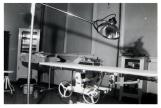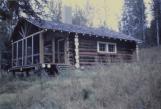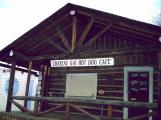14
Part of the Corpus Christi porcession, with altar made on hospital steps of St. Gabriel's Hospital1941
St. Gabriel's Hospital and outbuildings, Fort McMurray, Alberta, Canada
 Credits:
Credits:Mary O'Coffey
Fort McMurray Historical Society
15
St. Gabriel's Hospital front steps, converted into altar for Corpus Christi1941
St. Gabriel's Hospital and outbuildings, Fort McMurray, Alberta, Canada
 Credits:
Credits:Fort McMurray Historical Society
16
The Hospital BuildingWhen St. Gabriel's Hospital opened, it was a two-building structure with 16 beds and 4 bassinettes. The men's ward was on the main floor while the women's ward was on the second story. The maternity rooms and staff living quarters were also located on the second story. During its early use, the laundry and cooking facilities were kept in the basement; food was ferried up to patients using a manual dumb-waiter. Bedrooms for the sisters and lay nurses were also in the basement. The hospital included a chapel. During its use, the lay brothers performed repairs on the building and ensured that it was heated.
Space was limited in the hospital, but the fact that long-term patients were sent elsewhere eased the load a little. Nonetheless, during influenza epidemics the new hospital did not have enough beds for the number of patients who might check in. During these times, the Nuns and lay staff would give up their own beds for patients. If there were still not enough beds, they would have to double patients up. Due to the limitations on space, Father Lesage sent a letter to the Chamber of Commerce in 1945 requesting a fundraising drive for additional quarters, and in 1948 a separate house was built for nuns and staff. The new space allowed the administration to use their previous bedrooms for patient care. The new building also included a laundry facility, housing a commercial washing machine. This was a great improvement over hand-washing sheets and clothes in the kitchen.
In November 1958, a telephone line was added to the hospital. St. Gabriel's phone number was 2349. In the following year, l'Hôpital Saint Gabriel began receiving government assistance. In 1962, the administration organized another expansion. This time they added an X-ray department, a laboratory, and an operating theatre. Unlike other northern hospitals, St. Gabriel's was modern, well-equipped and well-trained.
The second floor of the hospital had a unique fire escape, according to Betty Golosky, registered nurse, who came to Fort McMurray in 1961. Instead of the typical stairs, there was a slide. It was never used in an emergency, but former nurses suggest that it may have been used for fun on occasion.
17
Aerial view of Fort McMurray in wintercirca 1959
Fort McMurray, Alberta, Canada
 Credits:
Credits:Bob Duncan
Fort McMurray Historical Society
18
Operating room in St. Gabriel's Hospital1939-1960
St. Gabriel's Hospital and outbuildings, Fort McMurray, Alberta, Canada
 Credits:
Credits:Les Soeurs de la Charité de Montréal, "Soeurs Grises" (The Grey Nuns of Montreal)
19
Life in the HospitalNuns were scheduled for ten-hour shifts, but were on call for twenty-four hours a day, since emergencies and births could happen during the day or the night. Their duties included visiting the elderly in their homes, extracting teeth, escorting patients to the hospital, immunizing children, operating the x-ray equipment, performing laboratory testing, and scheduling monthly check-ups. The Sisters cooked for themselves and their patients in the hospital kitchen, but often made enough to give to children from poor families who begged at the door for food. They gardened and they purchased fish and meat from local trappers. The nuns were also responsible for hiring non-religious staff, such as nurses and doctors, to help run the hospital. When possible, they hired people who otherwise would not have work, and they tried to create employment opportunities. For instance, Sister Cardinal refused to buy disposable syringes, as doing so would have put the person who sterilized syringes out of work. This sometimes put the nuns into conflict with hospital staff looking for cheaper or more effective solutions.
Elva Bussieres, local bookkeeper for the Grey Nuns, remembers that "the Nuns were frugal, but with heart. You almost felt guilty about asking for a replacement pen or pencil." When Elva was in the maternity ward as a patient herself, the nuns put flowers on her food tray.
The nuns dealt with a lot of poor patients. Often, new mothers did not have swaddling clothes for their infants, so the nuns collected blankets and baby clothes for them. They also gave away any supplies they did not need. Some nuns had a reputation for giving away things that they did need (see the entry on Sister Superior Lachambre).
L'Hôpital Saint Gabriel was not just a hospital; it was also a convent for the nuns and a place of local worship. Whenever there was a liturgical festival, such as Corpus Christi, the hospital was decorated in honour of it.
Getting to the hospital was technically the patient's responsibility. This could be problematic when the patient was badly injured or in labour. A new policy in the 1950s made hospitalization mandatory for deliveries by first time mothers or mothers giving birth to their fourth child (or more). The new policy made the transportation problem worse. Since women often waited until they went into labour before trying to get to the hospital, the ordeal of childbirth could be preceded by the ordeal of getting to the hospital. Bushplanes, helicopters, and dogsleds all carried pregnant women to St. Gabriel's during its career.
Sister Nadeau reminisced: "Fort McMurray's was very different from all the other hospitals in the north. It served a different kind of people. There were Crees, Montagnais, Métis and more non-Aboriginal people than other northern missions. We had a more balanced diet and we were never in want. There were no long-term tuberculosis patients in our hospital. We had a good supply of medicine and hospital equipment. We had a good supply of water though it was quite a rusty kind of water from a well."
20
Nurses rest in St. Gabriel's Hospital basement bedroomscirca 1941
St. Gabriel's Hospital and outbuildings, Fort McMurray, Alberta, Canada
 Credits:
Credits:Winnie Hutchinson
Fort McMurray Historical Society
21
Men carrying a patient on a stretcher into St. Gabriel's Hospital1939-1948
St. Gabriel's Hospital and outbuildings, Fort McMurray, Alberta, Canada
 Credits:
Credits:Les Soeurs de la Charité de Montréal, "Soeurs Grises" (The Grey Nuns of Montreal)
22
Chateau GaiThe Oblates built the Chateau Gai in 1960 as a residence and 'relaxation centre' for the Grey Nuns, in thanks for their hard work at the Saint Gabriel Hospital and Saint John's Separate School. It was located on the hillside near Hardin Street and Highway 63. The Grey Nuns from the school and the hospital would knit, socialize, or otherwise relax here, and they invited the lay nurses to join them.
Chateau Gai is now preserved in Heritage Park.
23
Chateau Gai, a retreat for the Grey Nuns, at its original location1978
Chateau Gai, Fort McMurray, Alberta, Canada
 Credits:
Credits:Fort McMurray Historical Society
24
Chateau Gai at Heritage Park9 November 2009
Heritage Park, Fort McMurray, Alberta, Canada
 Credits:
Credits:Suzanne Braat
25
Important Fort McMurray Medical FiguresMary Feniak was hired by the Grey Nuns of Montreal to move to Fort McMurray and work as a lay nurse in the hospital in 1941. A few weeks before her move to the northern community, she heard a Fort McMurray man named Lowry O'Coffey send greeting to his family over the radio, and she decided that he would be her boyfriend when she arrived. Eventually they wed, and left Fort McMurray in the early 1950s.
Dr. "Rick" McCallum was Fort McMurray's second physician and the first doctor to practice in l'Hôpital St. Gabriel. He practiced in the community from 1934 until 1938, serving Fort McMurray itself and the surrounding settlements.
Dr. Leigh Brown was the first to use antibiotics in Fort McMurray, using streptomycin in 1946 to cure a child dying of tubercular meningitis. Penicillin was invented in 1928, but antibiotics did not become popular until their efficacy was proven in the Second World War. In the following decades, a number of antibiotics were invented and their use spread into western and northern Canada. Thanks to this, many 'incurable' diseases were cured within a week or two.
Dr. Brown arrived in Fort McMurray in 1946 and treated patients out of the Franklin Hotel. He and his wife Nan purchased a home in Fort McMurray and he moved his practice into his house. Not only did he administer the first antibiotics, but he also performed Fort McMurray's first Caesarean section with anaesthetic. Dr. Brown also treated animals. Occasionally, children would bring him their dolls when they needed repair, reasoning that if he could heal sick people, he could heal sick dolls, too. In 1947 he was appointed Health Officer, and he and his family left Fort McMurray on 30 May 1950.
Residents of Fort McMurray could count on Dr. McDonald to give them two aspirin for whatever ailment they had, wherever they might run into him. He carried pocketfuls of aspirin with him and included animals in his unofficial prescriptions as well. On 22 April 1959, Dr. McDonald delivered Benny Hume's son Kenneth. According to Sister Gilbert, Kenneth was the first infant of Chinese descent born in the hospital.
Dr. Steven Yung was the area's first Chinese doctor, working in the hospital from 1964-1968. When he arrived, he was the only doctor in Fort McMurray. He was paid by the Great Canadian Oil Sands Company, by the Department of Indian Affairs, and by the town of Fort McMurray itself.
26
Nurse Mary O'Coffey standing next to St. Gabriel's Hospital1941
St. Gabriel's Hospital and outbuildings, Fort McMurray, Alberta, Canada
 Credits:
Credits:Tony O'Coffey
Fort McMurray Historical Society
27
Dr. Malcolm "Rick" McCallum with wife (third from left) and friends at the Snye1934-1938
Fort McMurray, Alberta, Canada
 Credits:
Credits:Sheila Collier (McDonald)
Fort McMurray Historical Society